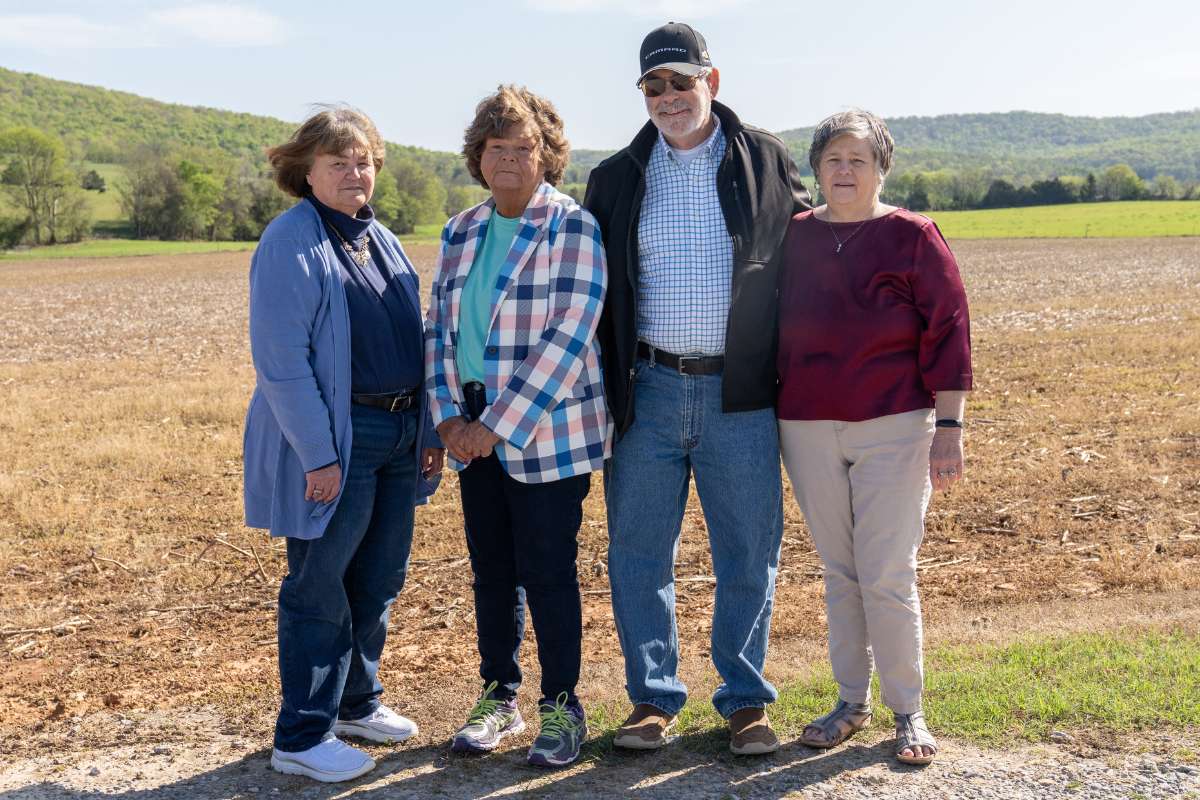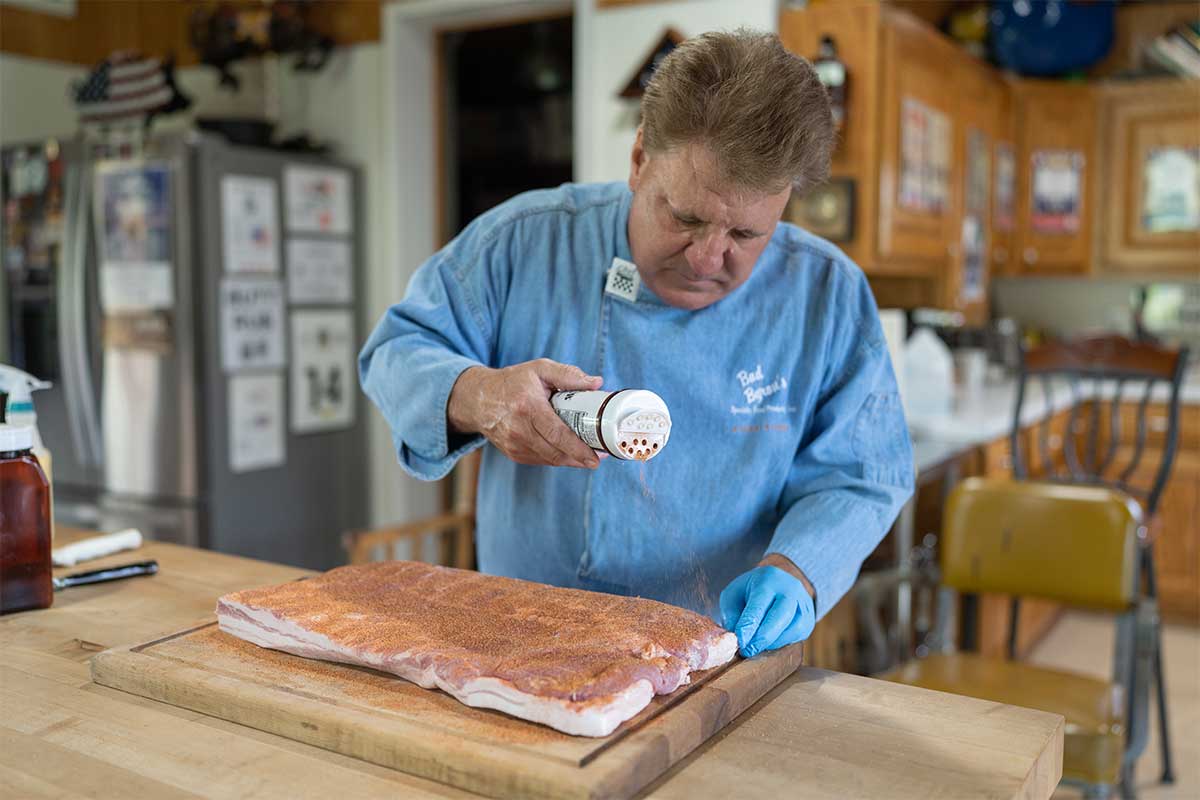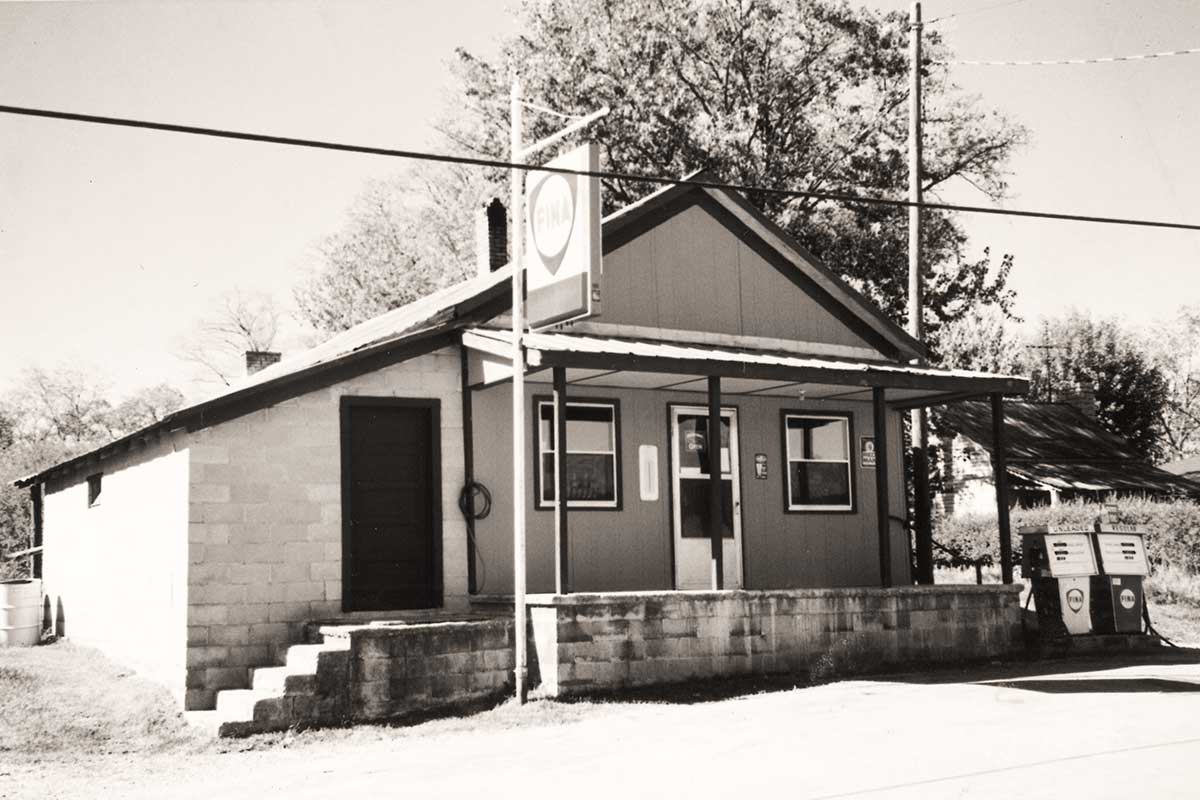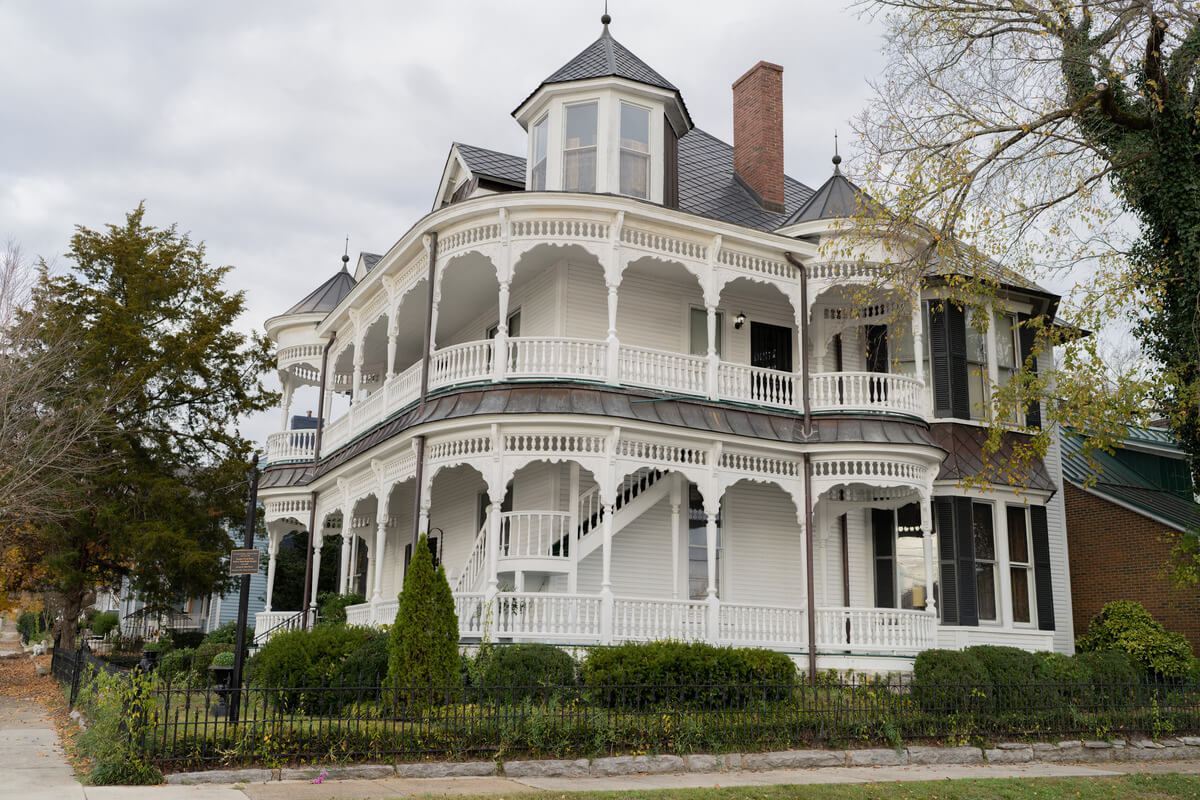
Sam Smiley: From patrols to purpose
DEPUTY SAM Smiley stood at the front of the fifth-grade classroom, feeling the weight of expectant eyes. As he asked the students to name responsibilities at home or school, some answered eagerly,...
More Good News

DEPUTY SAM Smiley stood at the front of the fifth-grade classroom, feeling the weight of expectant eyes. As he asked the students to name responsibilities at home or school, some answered eagerly,...

ANITA ASHWORTH pulled open the door to the Warrior Exhibit. Outside, traffic circled the square, everyday life in motion — its freedom preserved by those remembered within these walls. Time slowed...

WHILE THE fields no longer stretch unbroken to the horizon, what remains is rooted deep. The land carries the weight of generations — hands that cleared the first fields, feet that walked familiar...

TIFFANY AND Liam Calvert are the owners of Magic Athletics. They have been anchored in the community for years and began their business at the old cotton mill. It was a space they quickly outgrew...

FROM THE corner of your eye, Mt. Washmore looms — laundry stalled by a dead washing machine. The big box store’s helpline? Forty-five minutes on hold, promising you’re “next.” It hasn’t always been...

TRAFFIC CRAWLED along Lincoln Avenue, a backhoe leading the way, soon joined by a Fayetteville Police Department car’s flashing blue lights. The officer eased the machine over, clearing the way for...

MAPS TELL stories of possibility. Not the kind printed on paper but the invisible routes we chart through life’s most challenging terrains. Some journeys are straightforward highways; others are...

AS YOU wait in the car rider lane for your student to emerge from one of Lincoln County’s schools, it’s hard to see. The double doors burst open, and students pour out, run-walking to their rides,...

ON THE beach of Playa Junquillal, Costa Rica, Makayla Martin gently releases baby sea turtles one by one onto the beach. The tiny creatures, no larger than the palm of her hand, instinctively...

BILL SMITH broke the surface of Tims Ford Lake, his uncle, Bobby Smith, in one numb hand, and his 3-year-old son, Jess, clutched desperately in the other. The 48-degree water bit into their skin...

Open the door at 1622 Huntsville Highway and step over the threshold into Kaylee’s Korner. Vintage olive green stemware, opaque carnival glass, depression glass, teapots, coffee mugs, and snow-white...

The house was set way back from the road, old, run-down, and covered in weeds and poison ivy. Its roof had holes, the floor had deteriorated, and the basement was full of trash — but Keith Syler and...

With the morning sun and the center’s associates peeking over their shoulders, the senior adults gathered at the tables work intently on the day’s craft project. Their conversation is lively,...

His smile fills the brightest scenes in the film of her life’s memories. When Beth Andersen’s wobbling bicycle steadied, and she rode independently down the driveway, it was there. When she told him...

“I'm hungry” echoes in homes everywhere, often before backpacks even hit the floor and students kick off their school shoes. It’s a refrain as common as the afternoon sun, often met with the rustle...

On Thursday morning, June 20, 2024, the steady flow of vehicles in front of Walmart on Huntsville Highway was like every weekday. Many were headed to and from work in Huntsville. Some needed to stop...

AS THE morning sky fully awakened, its ombre pinks, blues, and yellows yielding to the full orb of the yellow sun, they waited. The men talked, gathered in clusters, many with coffee in hand, others...

IN THE West End Baptist Church fellowship hall, the weekly meeting of the Stitchin’ Sisters is in full swing. Lively conversation competes with the whirrrrr of the sewing machines. There’s the...

IN THE two-room schoolhouse in Howell, many things distracted students on an average day. Thoughts of recess, the sights of changing seasons, note-passing, and sports rivalries interrupted lessons...

SHE SLIPPED into her car, her shoulders and her spirits slumping from the weight of the shift that just ended. In no hurry, she turned the ignition, not to back out but to roll down her window,...

GROWING UP on a farm teaches you a lot about life — hard work, commitment, respect, and the resilience to get back up when you fall. For Leslie Copeland, these lessons have profoundly shaped her...

ON AN early April morning, green finial-capped shoots stand tall amid King Stropharia mushrooms, welcoming their caretaker, Don Adams. Bees make their presence known, guarding their queen in the...

“SMALL TOWN, big dreams” – four little words and a familiar cliche but one carrying a lot on its wings. For some, it represents a hope to see, learn, or experience more, not to escape something...

THE UPROAR surrounding the field becomes a distant murmur as Mia Brown digs her cleats into the pitcher’s plate. The mound is her sanctuary, a judgment-free zone where she can simply be herself. Her...

THE GRAZING table before you is no ordinary feed trough. It’s a feast for the senses — a vibrant patchwork of colors, textures, and flavors that beckons you to dive in and start sampling. Wedges of...

LIKE MANY boys his age, Danny Green started thinking about finding that special someone when he was 16. But it was different for him because what he saw in the mirror told him he was not just...

TAMMY MCCONNELL was never one to sit on the bench. Growing up on a dairy farm in Fayetteville, she learned the value of hard work and hustle. Basketball was her passion, and a full-ride scholarship...

ON THE second Saturday in December, volunteers with arms ringed with balsam wreaths tied with red velvet bows make their way among the headstones at cemeteries across the country. The sound of...

AS YOU step into Bogart’s Cigar Lounge, the door shuts in the face of whatever is weighing on you. The scent of rich, aged tobacco mingles with the lively hum of diverse voices engaged in...

FOR HOURS, they circled the wood floor, their wheels a muffled whir, keeping pace with the spirited music and crescendos of laughter. Then came the call signaling the end of the evening for many:...

IT’S A familiar but uncomfortable tradition and way of life. Countless times, we’ve walked the sidewalk as slowly as possible to the front doors of the funeral home, mentally rehearsing our...

FRESHLY BREWED coffee steaming in your favorite cup patiently waits as you fill a small plate with pats of butter. You slowly pour sorghum syrup over them, then swirl it together until the sweet,...

INSTEAD OF the usual clinking trays and not-so-muffled chatter, Lincoln County High School’s (LCHS) cafeteria vibrates with the boisterous hum of a community gathered. Seated around linen-covered...

THE SCENT of freshly brewed coffee mingles with the rustle of papers as the Home Visit Team convenes. Outside, the sun casts long shadows, reflecting the shades of hardship they are about to...

LINCOLN COUNTY — what do you know about it? Lifelong residents know Lincoln County as a tight-knit community that rallies to support its own in times of crisis. We know its country backroads, gently...

HELEN KELLER said at the 1925 Lions Club International convention, “Try to imagine how you would feel if you were suddenly stricken blind today. I appeal to you Lions, you who have your sight, your...

THE PLAYING field for high school football isn’t a hundred yards; it’s as large as the community’s hearts as they rally for their team and each other. Fayetteville High School’s Friday night lights...

SHE WAS so proud of him. Eric Torres’s full-ride scholarship for a mechanical engineering degree made his family proud. His grandmother was his rock and the most significant difference-maker in his...

AMERICAN AUTHOR Pierce Brown said, “Home isn’t where you’re from; it’s where you find light when all grows dark.” In a time like we’d never seen, the pandemic gave us many opportunities to find...

EVERY CHRISTMAS Day, families across the country gather to eat and fellowship together, sharing stories and seeing people they may not have seen all year. However, not everyone has the ability or...

THE DECISIONS and actions of past generations shape Lincoln County and Fayetteville’s landmarks, institutions, and culture. Though they are no longer here, their work, even down to their smallest...

GAIL GODWIN said, “Good teaching is one-fourth preparation and three-fourths pure theatre.” Tim Hobbs has utilized theatre in the classroom throughout his Fayetteville City Schools (FCS) career and...

THE CHRISTMAS season is all about the spirit of giving, and what better way to give than to help children in the community have a wonderful holiday season? The Lincoln County Toy Drive has been...

IN OUR moment of crisis, after dialing 911, the sight of first responders bursting onto the scene brings immediate relief. Help has arrived. In small communities like Belleville, it’s even better...

FAYETTEVILLE FEELS far removed from the high fashion runways of Paris, New York, and Milan, but it’s closer than you think. Within Lincoln County lies the inspiration for Juan Guerrero Designs, and...

FOR OVER two decades, former Sheriff Jimmy Mullins dedicated his life to law enforcement, ensuring justice and safety for the Lincoln County community. From heartfelt rescues to challenging...

IT’S ONE of our most basic needs, present from birth: the need to belong. To feel seen, heard, understood, and cared for is a critical part of our development at all ages. Karen Gardner saw the...

FAYETTEVILLE OUTDOOR Sports (FOS), formerly Fayetteville Cycle, has been serving Lincoln County and surrounding communities for over 40 years, the last of which has been under the ownership of David...

CHILDHOOD SHOULD be a careless time filled with love, comfort, and security, like a favorite snuggle blanket. But too many times, things look terribly different in some children’s lives. Neglect or...

AS SUMMER slowly surrenders to fall, the Lincoln County Fairgrounds welcomes the return of competition, community, and colorful midway excitement. Red, white, and blue buntings flutter as funnel...

AS WARM summer days linger, thoughts and plans for returning fall traditions cool us, if only in our minds. We plan decorative porches with corn stalk bundles, pumpkin piles, and mums. We dream of...

FROM INSPIRATIONAL NBA athletes and talented teammates to dedicated family members and compassionate coaches, former Riverside Christian basketball player Will Eldridge had a slam-dunk support...

IS THERE anything as polarizing, emotional, or inspiring as Tennessee Orange? Not in this neck of the woods. We wear the T-shirts, the jerseys, and the caps. We show up in the stands or cheer them...

AS FAYETTEVILLE High School's cross-country program flourishes under former triathlete coach Chris Davis, two of its top athletes have signed with college teams. Their athletic (and academic)...

MARK TWAIN once wrote, “The two most important days in your life are the day you are born, and the day you find out why.” A few days before the first football game of his senior season, Fayetteville...

OH, IF walls could talk! The building at 114 W. Market St. has served the public in one form or another since the 1860s when jail cells encased in limestone housed the city’s inmates. The walls were...

JOHNNY DEPP said, “My body is my journal, and my tattoos are my story.” American tattoo artist Kat Von D agreed when she said, “I am a canvas of my experiences; my story is etched in lines and...

CHECK YOUR pantry’s seasonings, and you may very well find a bottle with a perky, pantless pig smiling back at you. The journey of Bad Byron’s Butt Rub to a place at your table is seasoned with...

IT WAS a time when small communities were more than a place you drive through memorialized by a highway road sign — the town’s name was usually followed by “unincorporated.” Unincorporated is an...

NINE MONTHS of excitement and anticipation preceded his birth. The first-time parents checked all the boxes of preparation. They asked about the most used baby items, were showered with love and...

SURROUNDED BY her pre-K students, Tami Schumacher is exactly where she always wanted to be. As a child of a stay-at-home mom, she played school and knew she wanted to be a teacher and a mama....

FAYETTEVILLE’S MAIN Street is more than brick-and-mortar storefronts and festivals. It’s more than area business owners, leaders, shoppers, and nonprofits. It’s about raising up generations of...

AMID A sea of orange and white on a clear, crisp fall Saturday afternoon created for college football, the crowd snaps to its feet as the ball crosses the end zone. The band and the fans launch into...

SOMETIMES THINGS aren’t what they appear to be. After the class bell has sounded, she’s mistaken for a student remaining in the halls. She’s often asked to point out the head coach of the boys...

LARRY ROBERTSON always answered when they knocked on his door selling brooms and lightbulbs each year. He knew a little about their community service, and he wondered why they’d never asked him to...

YOU’LL FIND HIM less on the housetops and more in the office or out meeting customers in the field these days, but Lucas Garrett of T & L Roofing is content wherever you find him. Three years...

SUMMER’S NOT just for outdoors! Fellowship with friends and family while experiencing our area’s best arts and entertainment, indoors and out. Don’t forget the fireworks, but there’s more than...

SUMMER IS a season of warmth, joy, and fun. It is a time when people get together to enjoy the outdoors, dance to great music, and make unforgettable memories. Summer music festivals are a perfect...

ALTHOUGH THE first students won’t arrive for several more hours, the lunchroom at Riverside Christian Academy (RCA) is buzzing with activity. Pots and pans clang, cans are opened and produce is...

ART AND opportunities are found in everyday places, and on rare occasions, the two combine to create a unique career. Jessica Allen wasn’t looking for new work when she and her mother-in-law took a...

ANYONE WHO has lived in Fayetteville knows Higgins Funeral Home. Sadly, many of us have said goodbye to loved ones inside those walls. While it’s hard, the Higgins family is there for ours. Families...

FOR NEARLY 125 years, Carter’s Drug Store on the Fayetteville square has dispensed more than medicine to members of the Lincoln County community. To many, it’s been a steady job in good times and...

LIKE THE electricity powering your home's heating and cooling, you can't see it, but you can feel the results of it. At Highland Rim School, that thing you feel is the energy and effect of life in...

LIKE BAKING friendship bread, teaching requires patience, dedication, and the love of working with the ingredients: curious students, challenges at school, and a supportive community. Teaching...

LAID OFF for the second time from his factory job and newly married, Scott Posey considered a career change. He decided college would broaden his opportunities and attended Motlow State Community...

IMAGINE YOU’VE planned to spend several hours in your favorite bookstore. You schedule a time to search for a few good books for stolen quiet hours a few times each year. It’s something you always...

LAURA RADWAY Mayer always looked for the child on the playground with no one to play with, and it’s no different today. Her heart is bent toward women and children with broken hearts and lives, and...

SOME PEOPLE spend their life putting others before themselves. They show up at just the right time, armed with answers and resources, making the world a better place through their presence. Judy...

ON ANY day, countless people cross our paths. Some are distracted, some are irritated, some are angry, and some are hurting. We may be one of them. Who knows how a kind word might change their mood...

WHEN I first saw her, something told me, ‘I’m going to marry that girl someday,’” Donny Ogle said, the love in his voice strong 55 years later. “And she couldn’t stand me. I guess I was a little...

IN 2011, an overgrown hillside on the family farm needed attention, and David Robinson of Robinson Environmental Land Clearing got a call from an ad in the Farmers Exchange. Gina McGee’s brother...

IT WAS a perfect autumn day—blue skies, golden leaves, and cottony clouds. Just off the square at the intersection of Elk and Washington Streets stands the 1800s steamboat gothic home of Don Wyatt....

MARTHA CRAIG and Charlene Richardson share a bond that’s grown stronger over time. What started with Craig cleaning for Richardson in her home blossomed into an endearing friendship as the two spent...

THREE BROKEN mother-hearts form a circle of love and friendship, giving space for healing, remembering, and offering hope to each other and the world around them. “It’s not a club you want to join,”...

DREAMS CAN be hard things to follow. As you chase them, having a friend alongside you strengthens you for the journey. A group of like-minded friends becomes a brotherhood of believers, and the...

HOW CAN a word trigger so many emotional responses, and why is it fair that it does? While we could erase the word from the dictionary, doing so would do nothing to erase it from our lives. However,...

A CHILD STARES at the blank page. She can’t remember the teacher’s instructions and believes she can’t draw. Only artists can do that. And she’s not alone. From childhood to adulthood, it’s a...

THEY SERVED our country and protected our freedom. They sacrificed their time and put their lives on the line while we carried on dayto- day life, safely and comfortably. Today, many of them are...

LOOK AROUND the grocery store today andsee bewildered faces in every aisle. Buggies once packed to the brim are now carefully curated from half-empty shelves. Coupons and calculators are in hand....

SPEND 90 seconds with Jennie Schutte-Patrick, and you’ll know you’re about to get an education infused with passion and humor. It’s everywhere she is, and you’ll find this wife, mom, and chief of...

WHEN HE retired at the age of 64, James D. Wheeler felt that he had missed out on something in life. Wheeler, 86, was raised on a farm in Lincoln County cultivating cotton, watermelons, and other...

WHEN ENTERING a particular local restaurant located at 2715 Huntsville Highway Suite C in Fayetteville, the first thing you will notice is the friendly servers taking your order, happy that you are...

204 COLLEGE Street East, in Fayetteville, is a place where a special woman can make your favorite espresso drink any way you like it. Her name is Sheila Archer, and she can produce drinks fast. Java...

ON MAIN Avenue North, in downtown Fayetteville, a particular building sticks out. It is hard to miss with its red, white, and blue colors bursting with patriotic pride. On the exterior of the...

IT COULD have been a quilt they were gathered around. Beneath could have been small children playing and watching as needles passed through the layers of calico fabric. With snacks nearby and warm...

INSIDE THE pages of her favorite books, Sierra Arguello found a place of belonging but still longed for something that she couldn’t quite identify. In the early days of fifth grade, Arguello’s...

AS THE sun slips behind the grandstands, the drum corp marches the band toward the Lincoln County High School (LCHS) field. Students and spectators follow on their heels, many carrying their...

“They want a better life. They want a better life and more opportunities for their children. The majority of the immigrants that come to America, that’s what they’re looking for,” she said. It’s the...

MENTION YOUTH sports and organized athletic teams naturally come to mind – football, basketball, baseball, softball, soccer – well, you see the common thread, don’t you? It’s a ball, but there are...

AS CHARLOTTE HOOPER attended regular services at The Father’s Refuge Church, she saw more than hymnals and church bulletins; she saw children and families in need. Wanting to help, she and her...

WHEN EDIE MARTIN graduated in 1999, she was deeply saddened. A Falcon at heart, she left Lincoln County High School only long enough to obtain her teaching degree. “It hurt me not to be there and be...

“FREEDOM” enters the chatroom, and immediately it’s all, barbecued meat and who’s got the biggest bang of a firework show. While Independence Day is our nation’s designated time to pause and...

DICK CLARK said “music is the soundtrack of your life.” Eric Michael Taylor would say music is his life, and he enjoys writing and performing the soundtracks of your life. Taylor’s music style...

BEING ABLE to recognize people that have had huge impacts on the lives of others is always a special occasion. I am so proud to be able to share with all of you, the celebration of the career of an...

FOR COREY Buckner, the path of his life changed in an instant. A diagnosis of Stage 2a Hodgkin’s Lymphoma in 2013 shifted his focus from life’s ordinary routines and dreams to a fight for his life....

IF THE Japanese proverb that says happiness is to hold flowers in both hands is true, Sharon Guntherberg is one of the happiest people in Lincoln County, if not the world. And it’s a happiness she...

LESS THAN two miles from the Fayetteville square, a 50-acre farm provides local products to the Lincoln County community. Eli and Jessica Buckley, owners of Buckley Farm, are native to Fayetteville...

AN OLDER gentleman living across the street shows himself peculiar in this world, addicted to speed and noise. Our world rushes and zips by, yet he stands unmoved and never in a hurry. The way he...

Many of us, especially our younger generations, do not realize the ease and accessibility our modern world has provided. Yes, life naturally can still present challenges of its own. However, we are...

IF THERE is one thing I have found to be true over the years, it is this: there is always more to the story. A man’s garage lined with bins full of recycling matter seems to be pure laziness. “Why...

IT’S HARD to imagine now, but there was a time when women weren’t allowed to cross the Fayetteville downtown square unattended. In the mid-1800s, several saloons were located around the square, and...

TOMMY GRAHAM’S uncommon job is not one many would choose. Known to many for his mortuary work, people naturally ask why he would choose such a career. “Truthfully, I really don’t know why. It was...

INSIDE SKILLED nursing facilities, time moves at different paces: the residents’ and everyone else’s. The employees escape to a world filled with things to do, places to go, and people to see when...